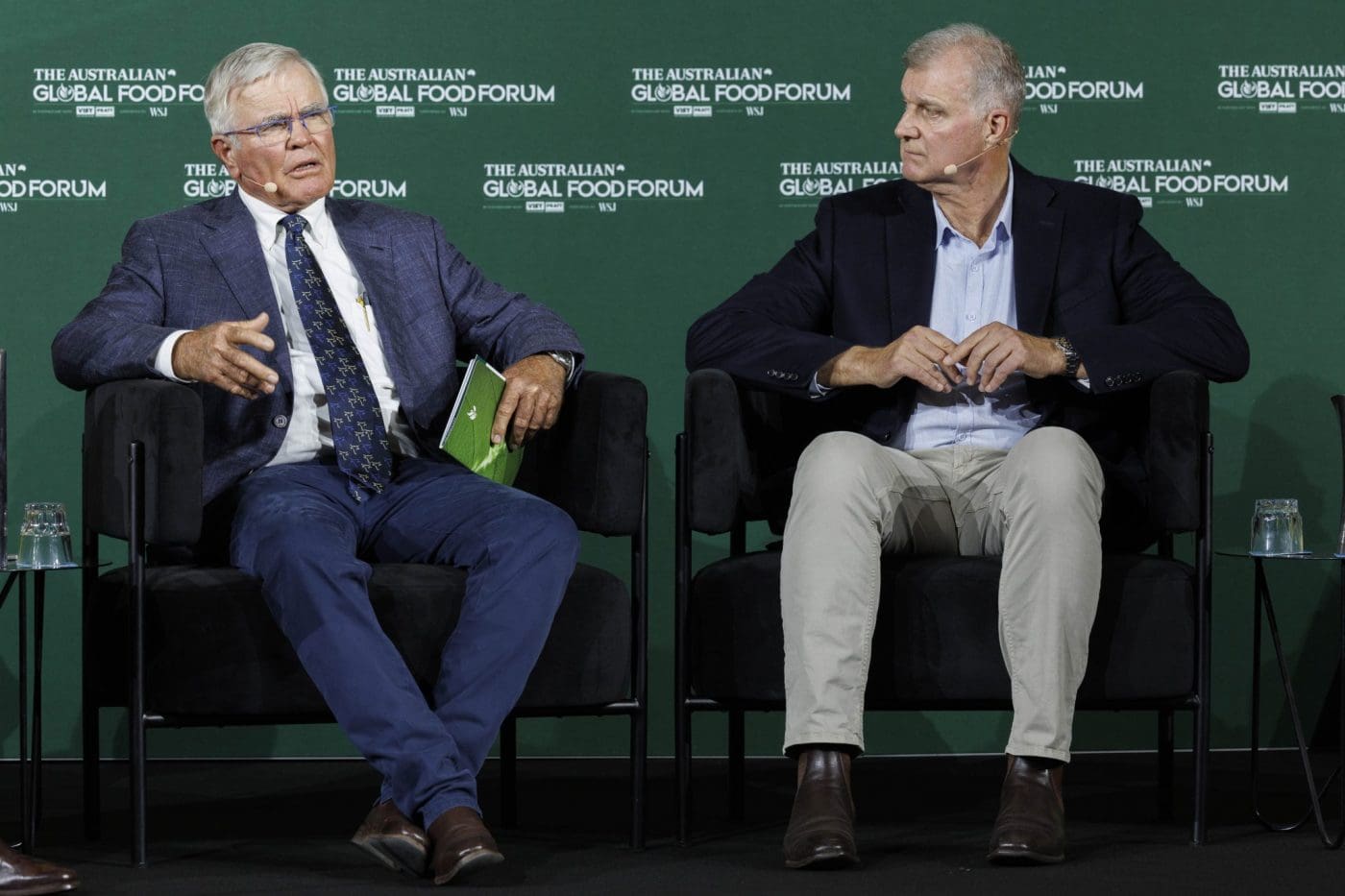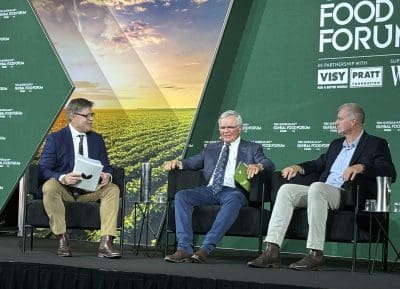
Peter Hughes and Tim Roberts Thomson speaking at The Australian’s Global Food Forum in Brisbane on Wednesday. Picture: Glenn Hunt / The Australian
TWO of Australia’s largest cattle producers have provided an optimistic assessment of where they believe cattle prices are heading, while also expressing confidence that the processing sector can handle increased numbers coming forward as Australia’s herd returns to historically high levels.
Peter Hughes and Tim Roberts Thomson told The Australian’s Global Food Forum in Brisbane on Wednesday that global supply and demand dynamics are pointing to higher prices ahead for Australian cattle producers.
Peter and Jane Hughes and their family’s Hughes Pastoral Group and Georgina Pastoral Company have grazing properties covering 3.6 million hectares of the Northern Territory and Queensland and running 200,000 mostly purebred Wagyu cattle.
Tim Roberts Thomson forged a successful corporate career as a founding shareholder of telecommunications giant Hutchison Australia and has built TRT Pastoral Group with his family over the past 30 years, comprising a substantial portfolio of properties across Victoria, Tasmania and King Island running 30,000 head of pure Angus cattle and a dairy herd.
Mr Hughes and Mr Roberts Thomson both referenced the vastly reduced US cattle herd, which has dropped to a 73-year-low of 87 million head, as a likely driver of increased export demand for Australian beef in coming years.
Cow prices a positive sign
Rallies in the 90CL Frozen Cow export beef price to the US were a positive sign, Mr Hughes said.
“The money they are paying for 90CL – all my life, it floats the boat.
“When it comes up usually the market comes up with it.
“It has been a bit slow and everybody knows what is going on now and we expected it to happen a lot quicker, so it is holding us out at the moment, but I think everything looks pretty positive for the industry in the future.”
Brazil also approaching herd rebuild
Mr Roberts Thomson said the US is expected to go into a herd rebuild at some stage and there were also signs Brazil will follow later this year.
“So there is a lot of positive things I think for the beef industry in the next few years.”
Can processors handle a larger herd?
Australia’s cattle herd has returned to a 10-year-high of 29 million head which is returning to cyclically high levels.
Mr Hughes predicted that while cattle numbers were unlikely to increase greatly, northern farming developments could lead to substantial increases in beef production from the existing herd.
“Every feedlotter you talk to is expanding, doubling their capacity,” he said.

Beef Central’s James Nason interviewing Peter Hughes, Hughes Pastoral Group and Tim Roberts Thomson, TRT Pastoral Group, at The Australian’s Global Food Forum in Brisbane on Wednesday. Picture: Tracey Hayes
“And as we get into the north with the Kimberley, once the farming becomes mature and they have cotton gins up there, and we get feed that we can get from the farmers and they start feedlotting, well then there will be an opportunity to build a processing plant up in that area.”
Both producers felt Australia’s processing capacity, which has long been reporting labour availability challenges, would be able to meet the challenge of handling the higher turnoff from a larger herd and fully capitalise on the demand opportunities emerging for Australian beef.
“Usually when the processing sector is confronted with this, normally they cope, find ways and are innovative in the way they do it,” Mr Hughes said.
“So I think, maybe what is holding us back at the moment is the problem they are talking about, but I am sure they will get through.”
Mr Roberts Thomson said recent investments and expansions in southern processing plants had created additional capacity for an extra 3500 head per day.
“That is positive, because we have had times recently where we have waited six to eight weeks to get a space in the processing plant, so it is badly needed.”
Mr Roberts Thomson said increases in feedlot capacity were potentially also needed, with Australia’s lot feeding sector currently feeding 1.2 million cattle and pretty much full.
Vertical integration
Mr Hughes said there were no plans to vertically integrate his family’s business into processing and branded beef production.
“I think it is more tricky, I’m used to the pastoral side of it.
“Once we move into processing and feedlotting it is a whole new business and it requires so many resources and so much more effort that something usually has to give ,and it is usually the cattle properties aren’t cared for or looked after as well as they could be.
“And when you go further down the line there is always a huge amount of money required to get you over the hump and that is where the pastoral side of it usually misses out.”
Mr Roberts Thomson said with properties on King Island which had a fantastic reputation and provenance, he was open to the idea.
“We have investigated it, we still haven’t done anything about it, but we would love to own further up the value chain to stop being a price taker back here as a producer.
“So we haven’t said no but at this stage we are reluctant to take that next step.”
Methane tax would “destroy” industry
Peter Hughes said he was very concerned about moves to introduce methane taxes on cattle, such as in Denmark which recently announced its plans to introduce a tax worth almost A$150 per cow per year.
Such a tax would “destroy the pastoral industry” if introduced here.
“I don’t think it is justifiable,” he said.
“I am very concerned about it.
“I think we have to fight hard for our industry and I think if Government move that way they will go along towards destroying the pastoral industry.
“The pastoral industry has developed over many, many years, it is unique to Australia, no one else looks after the pastoral side of it like the people that have been in it, like AA Co for 200 years, and this would go a long way towards destroying it.
“When that happens land values go down, no one wants to invest in it and it will turn into a gathering and a harvesting operation where looking after the environment and the animals will come secondary.
“It would be a disaster if that happened.”
Biosecurity risk
Tim Roberts Thomson said biosecurity remained a front-of-mind threat for the cattle industry.
“We have 63,000 beef farms, people involved in the beef industry in Australia, that covers about 43pc of the Australian land mass.
“You have 188,000 people directly employed, you have for about 240,000 indirectly employed, so a total of 430,000.
“If we had a biosecurity risk of something coming into this country it would be a disaster.
“We saw when it was in the headlines FMD where there was that case that was detected in Indonesia, orders were stopped straight away, so it would be absolutely a disaster.”
Economy of scale “sweet spot”
Asked what was considered the “ideal scale” to provide the optimum balance between costs and returns in their respective regions, Mr Hughes told the forum that once upon a time 6000 cattle was the number required to be viable.
It came down to each individual enterprise, he said, pointing out that family situations were usually the most efficient.
“They’re all very capable and they all do a great job, It is the most efficient way to go.
Mr Roberts Thomson said the “sweet spot” was a moving target.
“At the end of 2022 when the beef price crashed, we’re now getting the prices we got in 2014-2015, so nine or 10 years we have gone backwards.
“So in our analysis we think now that our herd size has got to be about four times what it was to have a substantial or a successful business.”
